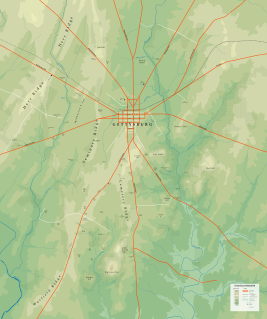 W
WThe Gettysburg Battlefield is the area of the July 1–3, 1863, military engagements of the Battle of Gettysburg within and around the borough of Gettysburg, Pennsylvania. Locations of military engagements extend from the 4-acre (1.6 ha) site of the first shot at Knoxlyn Ridge on the west of the borough, to East Cavalry Field on the east. A military engagement prior to the battle was conducted at the Gettysburg Railroad trestle over Rock Creek, which was burned on June 27.
 W
WThe Gettysburg Battlefield Historic District is a district of contributing properties and over 1000 historic contributing structures and 315 historic buildings, located in Adams County, Pennsylvania. The district was added to the National Register of Historic Places on March 19, 1975. Most of the contributing elements of the Gettysburg Battlefield are on the protected federal property within the smaller Gettysburg National Military Park.
 W
WThe monuments of the Gettysburg Battlefield commemorate the July 1 to 3, 1863 Battle of Gettysburg in the American Civil War. Most are located within Gettysburg National Military Park; others are on private land at battle sites in and around Gettysburg, Pennsylvania. Together, they represent "one of the largest collections of outdoor sculpture in the world."
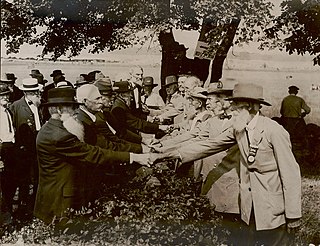 W
WThe 1913 Gettysburg reunion was a Gettysburg Battlefield encampment of American Civil War veterans for the Battle of Gettysburg's 50th anniversary. The June 29–July 4 gathering of 53,407 veterans was the largest ever Civil War veteran reunion, and "never before in the world's history [had] so great a number of men so advanced in years been assembled under field conditions". All honorably discharged veterans in the Grand Army of the Republic and the United Confederate Veterans were invited, and veterans from 46 of the 48 states attended.
 W
WThe 1938 Gettysburg reunion was an encampment of American Civil War veterans on the Gettysburg Battlefield for the 75th anniversary of the Battle of Gettysburg. The gathering included approximately 25 veterans of the battle with a further 1,359 Federal and 486 Confederate attendees out of the 8,000 living veterans of the war. The veterans averaged 94 years of age. Transportation, quarters, and subsistence was federally funded for each veteran and their accompanying attendant. If an attendant was needed it was provided. President Franklin D. Roosevelt's July 3 reunion address preceded the unveiling of the Eternal Light Peace Memorial; a newsreel with part of the address was included in the Westinghouse Time Capsule for the 1939 New York World's Fair.
 W
WThe Battle of Gettysburg was fought July 1–3, 1863, in and around the town of Gettysburg, Pennsylvania, by Union and Confederate forces during the American Civil War. The battle involved the largest number of casualties of the entire war and is often described as the war's turning point due to the Union's decisive victory and concurrence with the Siege of Vicksburg. Union Maj. Gen. George Meade's Army of the Potomac defeated attacks by Confederate Gen. Robert E. Lee's Army of Northern Virginia, halting Lee's invasion of the North.
 W
WBig Round Top is a boulder-strewn hill notable as the topographic high point of the Gettysburg Battlefield and for 1863 American Civil War engagements for which Medals of Honor were awarded. In addition to battle monuments, a historic postbellum structure on the uninhabited hill is the Big Round Top Observation Tower Foundation Ruin.
 W
WBig Round Top is a boulder-strewn hill notable as the topographic high point of the Gettysburg Battlefield and for 1863 American Civil War engagements for which Medals of Honor were awarded. In addition to battle monuments, a historic postbellum structure on the uninhabited hill is the Big Round Top Observation Tower Foundation Ruin.
 W
WCamp Colt was a military installation near Gettysburg, Pennsylvania used for Tank Corps recruit training prior to deployment in World War I. The camp used the Gettysburg Battlefield site of the previous Great Reunion of 1913 and the preceding 1917 World War I recruit training camp for U.S. troops along the Round Top Branch.
 W
WCamp Letterman was an American Civil War military hospital, which was erected near the Gettysburg Battlefield to treat more than 14,000 Union and 6,800 Confederate wounded of the Battle of Gettysburg at the beginning of July, 1863.
 W
WCemetery Hill is a landform on the Gettysburg Battlefield that was the scene of fighting each day of the Battle of Gettysburg. The northernmost part of the Army of the Potomac defensive "fish-hook" line, the hill is gently sloped and provided a site for American Civil War artillery.
 W
WCemetery Ridge is a geographic feature in Gettysburg National Military Park, south of the town of Gettysburg, Pennsylvania, that figured prominently in the Battle of Gettysburg, July 1 to July 3, 1863. It formed a primary defensive position for the Union Army during the battle, roughly the center of what is popularly known as the "fish-hook" line. The Confederate States Army launched attacks on the Union positions on the second and third days of the battle, but were driven back both times.
 W
WThe Consecration of the Soldiers' National Cemetery was the ceremony at which U.S. President Abraham Lincoln delivered the Gettysburg Address on November 19, 1863. In addition to the 15,000 spectators, attendees included six state governors: Andrew Gregg Curtin of Pennsylvania, Augustus Bradford of Maryland, Oliver P. Morton of Indiana, Horatio Seymour of New York, Joel Parker of New Jersey, and David Tod of Ohio. Reporters present included Joseph Gilbert, Charles Hale, John Russell Young ; and Cincinnati Commercial, New York Tribune, & The New York Times reporters.
 W
WCulp's Hill, which is about 3⁄4 mi (1,200 m) south of the center of Gettysburg, Pennsylvania, played a prominent role in the Battle of Gettysburg. It consists of two rounded peaks, separated by a narrow saddle. Its heavily wooded higher peak is 630 ft (190 m) above sea level. The lower peak is about 100 feet shorter than its companion. The eastern slope descends to Rock Creek, about 160 feet lower in elevation, and the western slope is to a saddle with Stevens Knoll with a summit 100 ft (30 m) lower than the main Culp's Hill summit. The hill was owned in 1863 by farmer Henry Culp and was publicized as "Culp's Hill" by October 31, 1865.
 W
WThe Cyclorama Building at Gettysburg was an historic modernist concrete and glass Mission 66 building dedicated November 19, 1962 by the National Park Service (NPS) to serve as a Gettysburg Battlefield visitor center, to exhibit the 1883 Paul Philippoteaux Battle of Gettysburg cyclorama and other artifacts, and to provide an observation deck. The building was demolished in 2013.
 W
WDevils Den is a boulder-strewn hill on the south end of Houck's Ridge at Gettysburg Battlefield, once used by artillery and infantry on the second day of the 1863 Battle of Gettysburg during the American Civil War. A tourist attraction since the memorial association era, several boulders are worn from foot traffic and the site includes numerous cannon, memorials, and walkways, including a bridge spanning two boulders.
 W
WEvergreen Cemetery – formerly called Citizen's Cemetery and Ever Green Cemetery – is a historic 29.12 acre rural cemetery located just outside Gettysburg Borough, in Cumberland Township, Adams County, Pennsylvania. It is part of Gettysburg Battlefield Historic District, and is surrounded by Gettysburg National Military Park and Soldiers' National Cemetery.
 W
WEvergreen Cemetery gatehouse (1855) is a historic building located at 799 Baltimore Pike in Adams County, Pennsylvania. During the American Civil War, the gatehouse played an important role in the July 1 to 3, 1863 Battle of Gettysburg. It is a contributing structure in Gettysburg Battlefield Historic District.
 W
WThe Brian Farm is an American Civil War area of the Gettysburg Battlefield used during the Pickett's Charge. On January 23, 2004, the farm's buildings, Boundary Stone Wall, and ID tablet were designated historic district contributing structures after the tract was used for the 1918 Camp Colt and other postbellum camps.
 W
WThe Gettysburg Battlefield Memorial Association (GBMA) was an historic preservation membership organization and is the eponym for the battlefield's memorial association era. The association was chartered by the Commonwealth of Pennsylvania on April 13, 1864, after attorney David McConaughy recommended on August 14, 1863, a preservation association to sell membership stock for battlefield fundraising. McConaughy transferred his land acquired in 1863 to the GBMA, and the association's boardmembers were initially local officials. The GBMA sold stock to raise money, hired a superintendent at $1000/yr, added to McConaughy's land holdings, and operated a wooden observation tower on East Cemetery Hill from 1878–95.
 W
WThe Gettysburg Electric Railway was a borough trolley that provided summer access to Gettysburg Battlefield visitor attractions such as military engagement areas, monuments, postbellum camps, and recreation areas. Despite the 1896 Supreme Court ruling under the Takings Clause against the railway, battlefield operations continued until 1916. The trolley generating plant was leased by the Electric Light, Heat, and Power Company of Gettysburg to supply streetlights and homes until electricity was imported from Hanover.
 W
WThe Gettysburg National Military Park protects and interprets the landscape of the 1863 Battle of Gettysburg during the American Civil War. Located in Gettysburg, Pennsylvania, the park is managed by the National Park Service. The GNMP properties include most of the Gettysburg Battlefield, many of the battle's support areas during the battle, and several other non-battle areas associated with the battle's "aftermath and commemoration", including the Gettysburg National Cemetery. Many of the park's 43,000 American Civil War artifacts are displayed in the Gettysburg Museum and Visitor Center.
 W
WThe Gettysburg National Tower was a 307-foot (94 m) hyperboloid observation tower that overlooked the Gettysburg National Military Park and Gettysburg, Pennsylvania, from 1974 to 2000. The privately owned tower attracted many of the battlefield's visitors, who paid a fee to access its observation decks. Controversial even before it opened, the structure was eventually seized by eminent domain and demolished.
 W
WLittle Round Top is the smaller of two rocky hills south of Gettysburg, Pennsylvania—the companion to the adjacent, taller hill named Big Round Top. It was the site of an unsuccessful assault by Confederate troops against the Union left flank on July 2, 1863, the second day of the Battle of Gettysburg, during the American Civil War.
 W
WThe Lutheran Theological Seminary at Gettysburg was a seminary of the Evangelical Lutheran Church in America (ELCA) in Gettysburg, Pennsylvania. It was one of seven ELCA seminaries, one of the three seminaries in the Eastern Cluster of Lutheran Seminaries, and a member institution of the Washington Theological Consortium. Founded in 1826, it was the oldest continuing Lutheran seminary in the United States until it was merged with the Lutheran Theological Seminary at Philadelphia to become United Lutheran Seminary on July 1, 2017.
 W
WMcPherson Ridge is a landform used for military engagements during the 1863 Battle of Gettysburg, when the I Corps of the Union Army had a headquarters on the ridge and was defeated by the Confederate division of Major General Henry Heth. The ridge has terrain above ~530 ft (160 m) and is almost entirely a federally protected area except for township portions at the southern end and along Pennsylvania Route 116, including a PennDOT facility. The northern end is a slight topographic saddle point on the west edge of Oak Ridge, and summit areas above 560 ft (170 m) include 4 on/near the Lincoln Highway, a broader summit south of the Fairfield Road, and the larger plateau at the northern saddle.
 W
WThe National Homestead at Gettysburg was the Gettysburg Orphanage, and a widows home, which opened in October 1866 on the Gettysburg Battlefield along Steinwehr Avenue on the north foot of Cemetery Hill.
 W
WOak Ridge is the landform of the Gettysburg Battlefield where the Eternal Light Peace Memorial was dedicated by President Franklin D. Roosevelt during the 1938 Gettysburg reunion. After the July 1, 1863 Battle of Oak Ridge, Whitworth rifled cannon fired from the Confederate position on Oak Hill onto Culp's Hill and Cemetery Hill. The ridge has numerous Battle of Gettysburg monuments and the 1895 Oak Ridge Observation Tower. In the 1920s, the Gettysburg Airport was established in the west slope of the ridge.
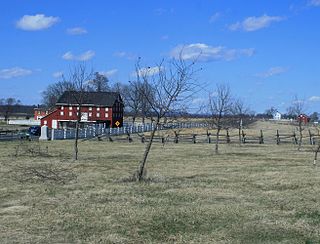 W
WThe Peach Orchard is a Gettysburg Battlefield site at the southeast corner of the north-south Emmitsburg Road intersection with the Wheatfield Road. The orchard is demarcated on the east and south by Birney Avenue, which provides access to various memorials regarding the "momentous attacks and counterattacks in…the orchard on the afternoon of July 2, 1863."
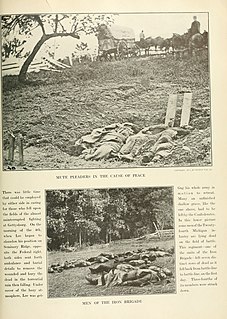 W
WRose Woods is a Gettysburg Battlefield forested area that is an American Civil War site of the battle's Hood's Assault, McLaws' Assault, and McCandless' Advance. "Scene of the first line of Union defenses" on the Battle of Gettysburg, Second Day; the 1st Texas Infantry and 3rd Arkansas Infantry Regiments attacked Ward's 2nd Brigade line in the woods. The last combat on the Battle of Gettysburg, Third Day, was "in the early evening. Colonel William McCandless's brigade of Pennsylvania Reserves advanced across the Wheatfield into Rose's Woods where they managed to inflict heavy losses on the 15th Georgia" which had failed to retreat to Warfield Ridge after Longstreet's Assault. Two days later Timothy H. O'Sullivan photographed corpses moved for burial to the edge of Rose Woods and which were subsequently reinterred in cemeteries.
 W
WSeminary Ridge is a dendritic ridge which was an area of Battle of Gettysburg engagements in July 1863 during the American Civil War (1861–1865), and of military installations during World War II (1941–1945).
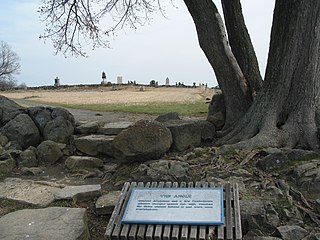 W
WThe Angle is a Gettysburg Battlefield area which includes the 1863 Copse of Trees used as the target landmark for Pickett's Charge, the 1892 monument that marks the high-water mark of the Confederacy, a rock wall, and several other Battle of Gettysburg monuments.
 W
WThe Wheatfield Road is a Gettysburg Battlefield crossroad from the Peach Orchard east-southeastward along the north side of The Wheatfield, north of the Valley of Death, and over the north foot of Little Round Top. In addition to modern tourist use, the road is notable for Battle of Gettysburg use and postbellum trolley use associated with the 1892-1896 US v. Gettysburg Electric Ry. case of the US Supreme Court.
 W
WWilloughby Run is a tributary of Marsh Creek in Adams County, Pennsylvania in the United States.